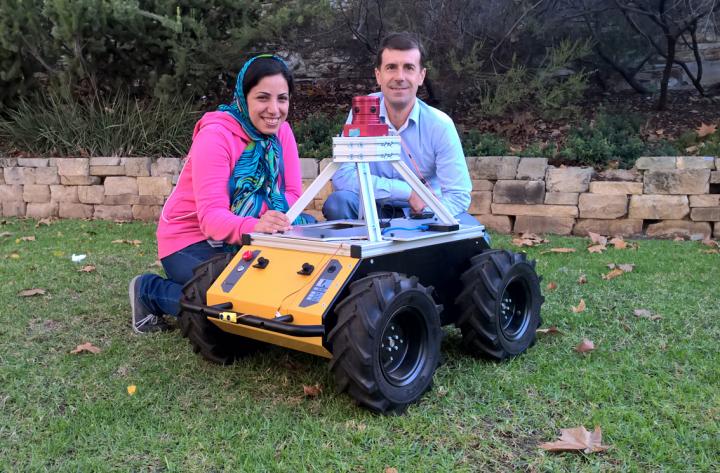Robot eyes will benefit from insect vision

University of Adelaide Ph.D. student Zahra Bagheri and supervisor Professor Benjamin Cazzolato (School of Mechanical Engineering) with the robot under development. The robot features a vision system using algorithms based on insect vision. Credit: The University of Adelaide
The project – which crosses the boundaries of neuroscience, mechanical engineering and computer science – builds on years of research into insect vision at the University.
In a new paper published today in the Journal of The Royal Society Interface, researchers describe how the learnings from both insects and humans can be applied in a model virtual reality simulation, enabling an artificial intelligence system to 'pursue' an object.
“Detecting and tracking small objects against complex backgrounds is a highly challenging task,” says the lead author of the paper, Mechanical Engineering PhD student Zahra Bagheri.
“Consider a cricket or baseball player trying to take a match-winning catch in the outfield. They have seconds or less to spot the ball, track it and predict its path as it comes down against the brightly coloured backdrop of excited fans in the crowd – all while running or even diving towards the point where they predict it will fall!
“Robotics engineers still dream of providing robots with the combination of sharp eyes, quick reflexes and flexible muscles that allow a budding champion to master this skill,” she says.
Research conducted in the lab of University of Adelaide neuroscientist Dr Steven Wiederman (School of Medical Sciences) has shown that flying insects, such as dragonflies, show remarkable visually guided behaviour. This includes chasing mates or prey, even in the presence of distractions, like swarms of insects.
“They perform this task despite their low visual acuity and a tiny brain, around the size of a grain of rice. The dragonfly chases prey at speeds up to 60 km/h, capturing them with a success rate over 97%,” Ms Bagheri says.
The team of engineers and neuroscientists has developed an unusual algorithm to help emulate this visual tracking. “Instead of just trying to keep the target perfectly centred on its field of view, our system locks on to the background and lets the target move against it,” Ms Bagheri says. “This reduces distractions from the background and gives time for underlying brain-like motion processing to work. It then makes small movements of its gaze and rotates towards the target to keep the target roughly frontal.”
This bio-inspired “active vision” system has been tested in virtual reality worlds composed of various natural scenes. The Adelaide team has found that it performs just as robustly as the state-of-the-art engineering target tracking algorithms, while running up to 20 times faster.
“This type of performance can allow for real-time applications using quite simple processors,” says Dr Wiederman, who is leading the project, and who developed the original motion sensing mechanism after recording the responses of neurons in the dragonfly brain.
“We are currently transferring the algorithm to a hardware platform, a bio-inspired, autonomous robot.”
###
Media Contacts:
Zahra Bagheri
PhD student
School of Mechanical Engineering
The University of Adelaide
zahra.bagheri@adelaide.edu.au
Dr Steven Wiederman
ARC Discovery Early Career Researcher
School of Medical Sciences
The University of Adelaide
Phone: +61 8 8313 8067
steven.wiederman@adelaide.edu.au
Media Contact
All latest news from the category: Information Technology
Here you can find a summary of innovations in the fields of information and data processing and up-to-date developments on IT equipment and hardware.
This area covers topics such as IT services, IT architectures, IT management and telecommunications.
Newest articles

Superradiant atoms could push the boundaries of how precisely time can be measured
Superradiant atoms can help us measure time more precisely than ever. In a new study, researchers from the University of Copenhagen present a new method for measuring the time interval,…

Ion thermoelectric conversion devices for near room temperature
The electrode sheet of the thermoelectric device consists of ionic hydrogel, which is sandwiched between the electrodes to form, and the Prussian blue on the electrode undergoes a redox reaction…

Zap Energy achieves 37-million-degree temperatures in a compact device
New publication reports record electron temperatures for a small-scale, sheared-flow-stabilized Z-pinch fusion device. In the nine decades since humans first produced fusion reactions, only a few fusion technologies have demonstrated…





















